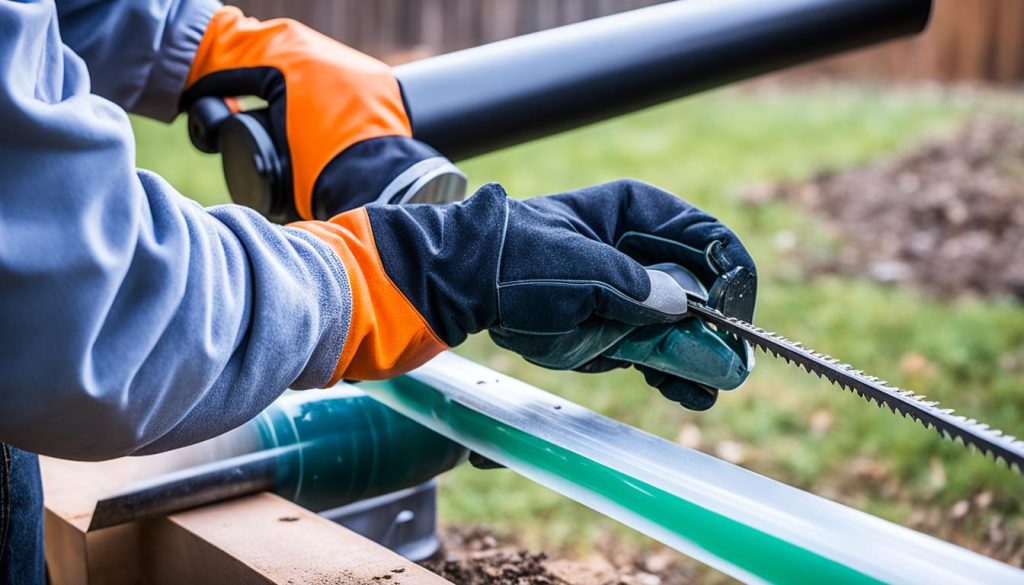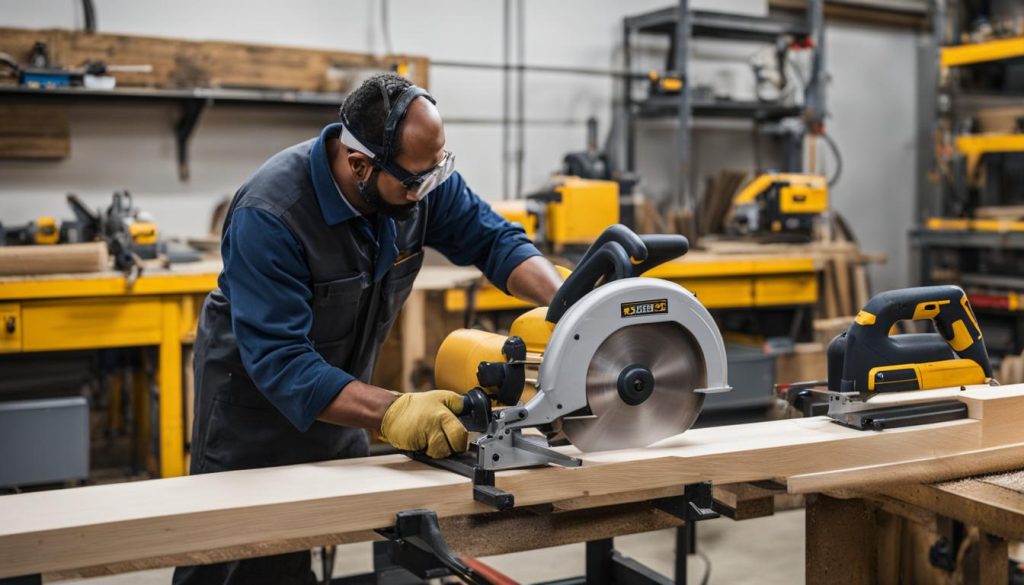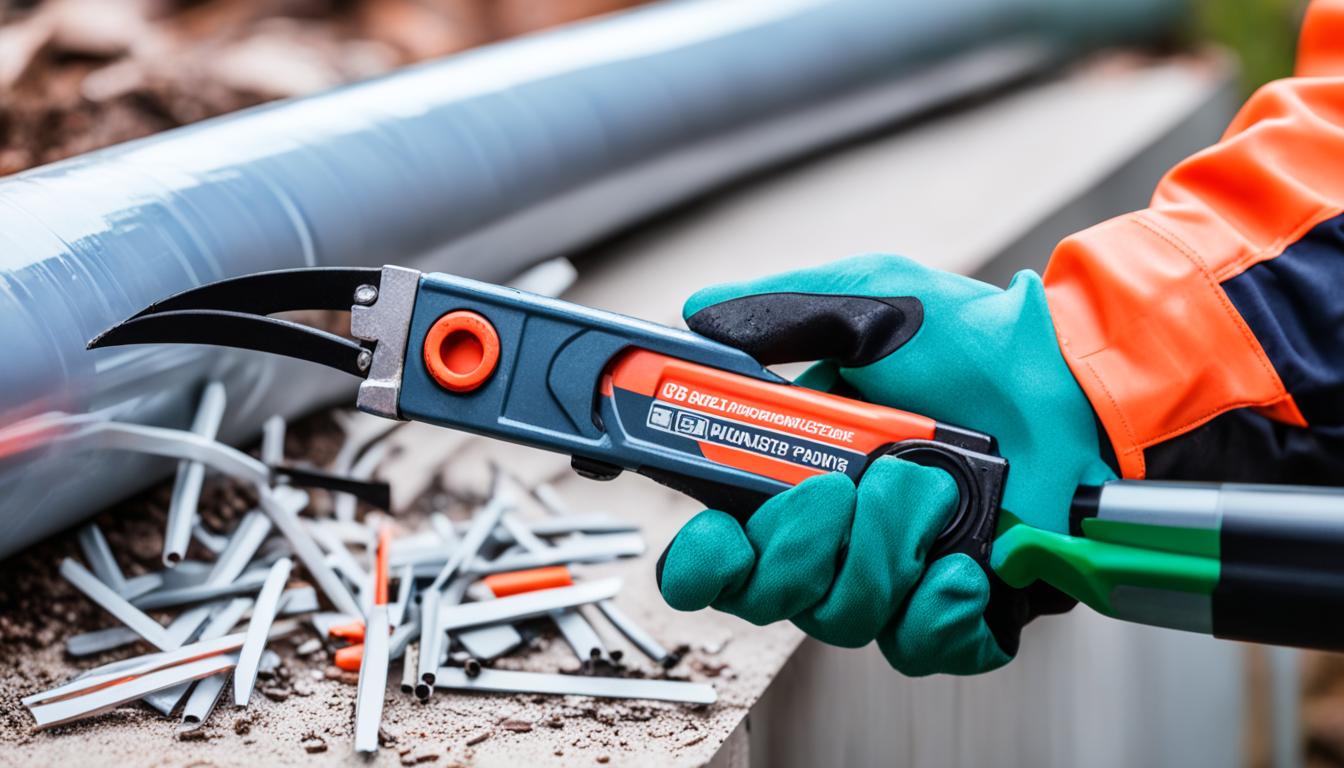Did you know that PVC pipes are used in a wide range of applications, including plumbing, irrigation, and construction? In fact, the global PVC pipe market is projected to reach a staggering $85.5 billion by 2026, showcasing the widespread use and importance of this versatile material.
When it comes to working with PVC pipes, knowing how to cut them safely and accurately is essential. Whether you’re a DIY enthusiast or a professional, having the right tools and techniques can make all the difference in achieving seamless cuts for your projects.
Key Takeaways:
- Understanding the different methods of cutting PVC pipe
- Choosing the right cutting tool based on project requirements
- Using plastic pipe cutters for smaller projects
- Opting for a hand saw for versatile cuts
- Utilizing an electric miter saw for large quantities
Using Plastic Pipe Cutters
When it comes to cutting PVC pipe, using plastic pipe cutters is a simple and efficient option. These tools are widely available and affordable at hardware stores, making them an excellent choice for beginners and DIY enthusiasts. Let me guide you through the process of using plastic pipe cutters for your PVC pipe cutting needs.
To start, make sure you have the necessary pvc pipe cutting tools at hand, including a pair of plastic pipe cutters. These special cutters are designed to slice through PVC pipe with precision, resulting in clean and accurate cuts. They are specifically built to handle the unique requirements of cutting PVC, making the task much easier and safer.
Here is a step-by-step guide on how to cut PVC pipe with plastic pipe cutters:
- Measure and mark the PVC pipe where you wish to make the cut. Ensure that your measurements are accurate and precise.
- Place the blade of the plastic pipe cutter against the mark on the pipe. Make sure the blade is positioned properly, ensuring a straight cut.
- Squeeze the handles of the cutter firmly to apply pressure onto the pipe. This pressure will allow the blade to penetrate the PVC pipe.
- Release the mechanism by opening the handles, and then squeeze them again to continue cutting. Repeat this motion until the blade cuts all the way through the pipe.
- Inspect the cut end of the pipe to ensure it is clean, smooth, and free of burrs. If any rough bits or burrs are present, use a utility knife or sandpaper to deburr the edges.
Plastic pipe cutters are particularly suitable for smaller projects that require less than ten cuts. They offer a clean and efficient cutting method, ensuring precise results every time. However, it’s important to note that frequent use of plastic pipe cutters can cause hand fatigue. Remember to take breaks and rest your hands to avoid discomfort or strain.
Now that you know how to use plastic pipe cutters for cutting PVC pipe, you can confidently tackle your DIY projects with ease. Plastic pipe cutters provide a convenient and beginner-friendly way to achieve accurate cuts, making them a valuable tool for any DIY enthusiast or homeowner.
| Advantages of Using Plastic Pipe Cutters | Disadvantages of Using Plastic Pipe Cutters |
|---|---|
| ● Affordable and widely available | ● Hand fatigue with frequent use |
| ● Simple and easy to use | |
| ● Clean and precise cuts |
Using a Hand Saw
When it comes to cutting PVC pipe, a hand saw like a hacksaw can be a valuable tool. Hacksaws are versatile and can be used for various cuts, making them suitable for DIY projects. Here’s a step-by-step guide on using a hacksaw to cut PVC pipe:
- First, mark the pipe where you want to make the cut. This will ensure accuracy and precision.
- Secure the pipe against a stable surface to prevent any movement or wobbling during the cutting process.
- Hold the hacksaw firmly, align the blade with the marked line, and start sawing back and forth in a straight motion.
- Apply steady pressure as you continue sawing until the blade cuts all the way through the pipe.
- After making the cut, use a butter knife or sandpaper to remove any rough bits or burrs from the cut end of the pipe, ensuring a smooth finish.
Hacksaws provide quick and efficient cuts, but some care must be taken to achieve clean results. Be mindful of the motion and pressure applied while sawing to maintain a straight cut. It’s important to note that hacksaws may leave rough edges, so deburring the cut end of the pipe is essential for a professional finish.
Remember, safety should be a top priority when handling tools. Always wear appropriate personal protective equipment, such as goggles and gloves, to protect yourself from any potential hazards.

| Pros | Cons |
|---|---|
| Versatile and suitable for various cuts | May leave rough edges if not used carefully |
| Easy to use and widely available | Requires manual effort and can be tiring for larger projects |
| Affordable option | Not as accurate as other cutting methods |
Using an Electric Miter Saw
An electric miter saw is the ideal tool for efficiently and accurately cutting large quantities of PVC pipe. With its power and precision, this tool ensures clean and smooth cuts, making it the go-to choice for professionals and DIY enthusiasts alike. However, it is crucial to prioritize safety when using an electric miter saw. Let me guide you through the process.

To begin, it is important to securely clamp the PVC pipe to the base of the miter saw, ensuring that it remains stable throughout the cutting process. This step is crucial to prevent accidents and ensure accurate cuts.
Next, carefully align the mark on the pipe with the saw blade. This alignment ensures that you achieve the desired length and angle for your PVC pipe. Take your time and double-check the alignment to avoid any errors.
Once the alignment is correct, activate the saw and slowly and steadily lower the blade onto the pipe. Allow the blade to cut through the PVC pipe smoothly and effortlessly. It is recommended to let the saw do the work and avoid forcing the pipe through the blade, as this can lead to uneven and jagged cuts.
Once the cut is complete, release the button and allow the blade to come to a complete stop before lifting the saw head. Safety should always be a top priority, and this simple precaution prevents any accidents during the process.
Tips for Cutting PVC Pipe
When it comes to cutting PVC pipe, achieving clean and straight cuts is crucial. To ensure your safety and precision, follow these helpful tips:
1. Choose the right cutting tool: Consider the size and number of cuts needed to determine the most appropriate tool for the job. Options include plastic pipe cutters, hand saws, and electric miter saws. Selecting the right tool will make your cutting task easier and more efficient.
2. Wear personal protective equipment (PPE): Safeguard yourself by wearing goggles and gloves. This protective gear will shield your eyes from debris and your hands from potential cuts.
3. Secure the pipe and work on a stable surface: Before cutting, ensure that the pipe is securely positioned and does not move during the cutting process. This will enable you to make precise cuts without any wobbling or slipping. Also, work on a stable surface to prevent accidents.
4. Deburr the cut end of the pipe: After cutting, use a deburring tool or a small knife to remove any rough bits or burrs from the cut end of the pipe. This step will result in a clean and smooth finish, making it easier to connect or fit the pipe securely.
By following these tips, you can safely and accurately cut PVC pipe with precision and ease. Remember to always prioritize safety and exercise caution when operating power tools. Happy cutting!
